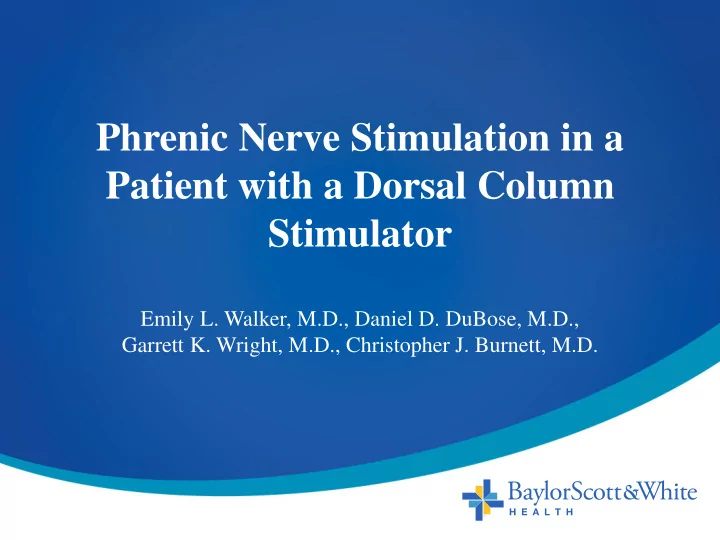

Phrenic Nerve Stimulation in a Patient with a Dorsal Column Stimulator Emily L. Walker, M.D., Daniel D. DuBose, M.D., Garrett K. Wright, M.D., Christopher J. Burnett, M.D.
Case Report • A 76-year-old female presented with recurrent muscle spasms across her left upper abdomen resembling a “hiccup.” • This began the evening her permanent DCS was placed. • Her DCS was turned off and she was started on metaxalone. 1
• She had undergone a successful trial with the Nevro system and did not experience diaphragmatic contractions. • Of note, the patient had a cardiac resynchronization therapy device with defibrillating capabilities (CRT-D) in place, which was interrogated before and after the trial with no interference reported. 2
• Placement of the permanent DCS was uneventful. • Her CRT-D was again interrogated before and after the permanent DCS placement with no interference reported. • Due to the timing of the DCS implantation and the onset of symptoms, it was thought that the spasms were somehow related to the new device. • Removal of the device was considered. 3
But how could a DCS cause these hiccups? 4
• Prior to device removal we contacted Cardiology. • Although rare, a lead from a CRT-D can lead to PNS with resultant diaphragmatic contractions resembling hiccups. • The patient was sent to the electrophysiology clinic where the voltage on her left ventricular lead was reduced and her symptoms resolved completely. 5
Discussion • To our knowledge, there are no reports in the literature of a DCS causing diaphragmatic contractions. • Injection of local anesthetic in the epidural space has been reported to cause persistent hiccups by an unknown mechanism (1) . • PNS is a well-known complication of CRT-D (2,3) , occurring in 33-37% of patients, and is a limiting factor when implanting left ventricular leads from coronary veins (4) . 6
• There are several ways the cardiologists can reduce the occurrence of PNS (5, 6, 7) . • Sometimes the coronary sinus lead may need to be repositioned or the voltage reduced. • In the case of our patient, the electrophysiology team was able to reduce the voltage in the left ventricular lead and her symptoms resolved completely. 7
• Historically, there has been concern regarding the combination of a DCS and pacemaker due to the possibility of false inhibition of the pacemaker. • There are case reports describing the safe use of a DCS in patients with a pacemaker (8) . • Additionally, there are studies that suggest that a DCS and pacemaker could be used together safely; however, individual testing is mandatory in each patient (9) . 8
Conclusion • Always consider other devices and potential interactions. • The pacemaker device company and electrophysiology team may be valuable resources. • Ultimately, due to the time, risks and expense of placing a DCS, it is imperative to specifically consider a patient’s CRT -D as the cause of diaphragmatic contractions prior to removing a DCS, even when the temporal relationship of the DCS and onset of new symptoms may suggest otherwise. 9
References 1. McAllister RK, McDavid AJ, Meyer TA, Bittenbinder TM. Recurrent persistent hiccups after epidural steroid injection and analgesia with bupivacaine. Anesth Analg. 2005;100:1834 – 6. 2. Doguet F, Honoré C, Godin B, Anselme F. Isolation of the phrenic nerve to suppress diaphragmatic contraction induced by cardiac resynchronization. J Cardiovasc Electrophys 2012;23(7):778-80. 3. Hjortshøj S, Heath F, Haugland M, Eschen O, Thøgersen AM, Riahi S, Toft E, Struijk JJ. Long pacing pulses reduce phrenic nerve stimulation in left ventricular pacing. J Cardiovasc Electrophys 2014;25(5):485-90. 4. Biffi M, Zanon F, Bertaglia E, Padeletti L, Varbaro A, De Santo T, Boriani G, Yang Z. Short-spaced dipole for managing phrenic nerve stimulation in patients with CRT: the “Phrenic nerve mapping and stimulation EP” catheter study. Heart Rhythm 2013;10(1):39 -45. 5. Toggweiler S, Kobza R, Roos M, Erne P. Visualizing pacemaker-induced phrenic nerve stimulation with acoustic cardiography. Pacing Clin Electrophysiol 2007;30(6):806-7. 6. Biffi M, Foerster L, Eastman W, Eggen M, Grenz NA, Sommer J, De Santo T, Haddad T, Varbaro A, Yang Z. Effect of bipolar electrode spacing on phrenic nerve stimulation and left ventricular pacing thresholds: an acute canine study. Circ Arrhythm Electrophysiol 2012;5(4):815- 20. 7. Sperzel J, Dänschel W, Gutleben KJ, Kranig W, Mortensen P, Connelly D, Trappe HJ, Seidl K, Duray G, Pieske B, Stockinger J, Boriani G, Jung W, Schilling R, Saberi L, Hallier B, Simon M, Rinaldi CA. First prospective, multi-centre clinical experience with a novel left ventricular quadripolar lead. Eurospace 2012;14(3):365-72. 8. Kosharskyy B, Rozen D. Feasibility of spinal cord stimulation in a patient with a cardiac pacemaker. Pain Physician 2006;9(3):249-51. 9. Ekre O, Börjesson M, Edvardsson N, Eliasson T, Mannheimer C. Feasibility of spinal cord stimulation in angina pectoris in patients with chronic pacemaker treatment for cardiac arrhythmias. Pacing Clin Electrophysiol 2003;26(11):2134-41. 10
Recommend
More recommend